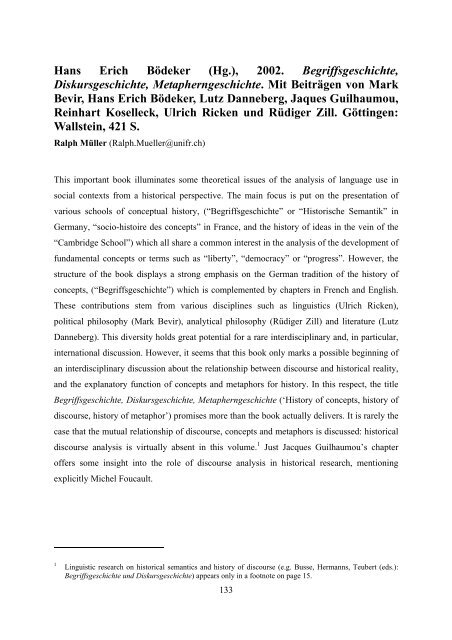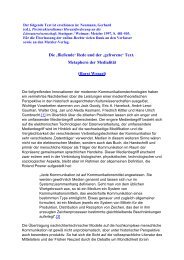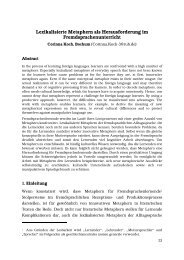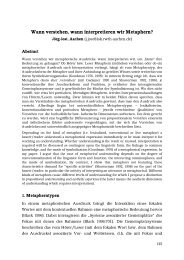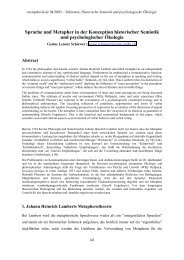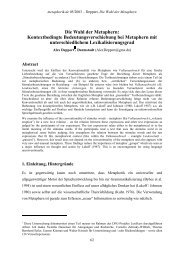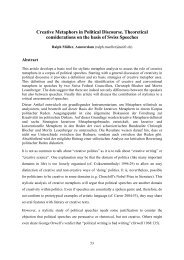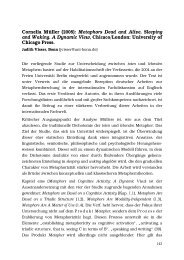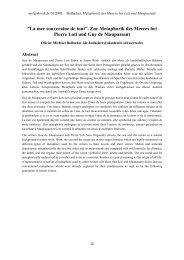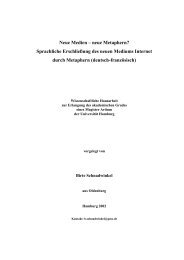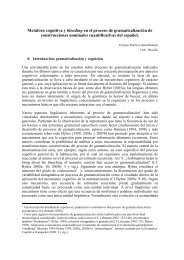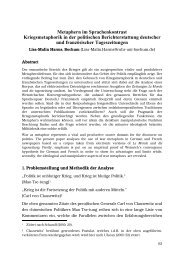Hans Erich Bödeker - metaphorik.de
Hans Erich Bödeker - metaphorik.de
Hans Erich Bödeker - metaphorik.de
You also want an ePaper? Increase the reach of your titles
YUMPU automatically turns print PDFs into web optimized ePapers that Google loves.
<strong>Hans</strong> <strong>Erich</strong> <strong>Bö<strong>de</strong>ker</strong> (Hg.), 2002. Begriffsgeschichte,<br />
Diskursgeschichte, Metapherngeschichte. Mit Beiträgen von Mark<br />
Bevir, <strong>Hans</strong> <strong>Erich</strong> <strong>Bö<strong>de</strong>ker</strong>, Lutz Danneberg, Jaques Guilhaumou,<br />
Reinhart Koselleck, Ulrich Ricken und Rüdiger Zill. Göttingen:<br />
Wallstein, 421 S.<br />
Ralph Müller (Ralph.Mueller@unifr.ch)<br />
This important book illuminates some theoretical issues of the analysis of language use in<br />
social contexts from a historical perspective. The main focus is put on the presentation of<br />
various schools of conceptual history, (“Begriffsgeschichte” or “Historische Semantik” in<br />
Germany, “socio-histoire <strong>de</strong>s concepts” in France, and the history of i<strong>de</strong>as in the vein of the<br />
“Cambridge School”) which all share a common interest in the analysis of the <strong>de</strong>velopment of<br />
fundamental concepts or terms such as “liberty”, “<strong>de</strong>mocracy” or “progress”. However, the<br />
structure of the book displays a strong emphasis on the German tradition of the history of<br />
concepts, (“Begriffsgeschichte”) which is complemented by chapters in French and English.<br />
These contributions stem from various disciplines such as linguistics (Ulrich Ricken),<br />
political philosophy (Mark Bevir), analytical philosophy (Rüdiger Zill) and literature (Lutz<br />
Danneberg). This diversity holds great potential for a rare interdisciplinary and, in particular,<br />
international discussion. However, it seems that this book only marks a possible beginning of<br />
an interdisciplinary discussion about the relationship between discourse and historical reality,<br />
and the explanatory function of concepts and metaphors for history. In this respect, the title<br />
Begriffsgeschichte, Diskursgeschichte, Metapherngeschichte (‘History of concepts, history of<br />
discourse, history of metaphor’) promises more than the book actually <strong>de</strong>livers. It is rarely the<br />
case that the mutual relationship of discourse, concepts and metaphors is discussed: historical<br />
discourse analysis is virtually absent in this volume. 1 Just Jacques Guilhaumou’s chapter<br />
offers some insight into the role of discourse analysis in historical research, mentioning<br />
explicitly Michel Foucault.<br />
1 Linguistic research on historical semantics and history of discourse (e.g. Busse, Hermanns, Teubert (eds.):<br />
Begriffsgeschichte und Diskursgeschichte) appears only in a footnote on page 15.<br />
133
<strong>metaphorik</strong>.<strong>de</strong> 11/2006 – Rezensionen / Reviews / Comptes rendus<br />
Metaphor in conceptual history<br />
Unfortunately, articles with a focus on conceptual history touch the issue of metaphor<br />
sporadically, and only the articles by Rüdiger Zill and Lutz Danneberg (which, however,<br />
cover roughly one half of the book) treat the historical analysis of metaphor in more <strong>de</strong>pth.<br />
This is unfortunate, as conceptual history became sensitive to the role of metaphor at a very<br />
early stage. For instance, the lexicon Geschichtliche Grundbegriffe (“Fundamental Concepts<br />
in History”, 9 volumes, 1972-1997), edited by Werner Conze, Otto Brunner and Reinhart<br />
Koselleck, inclu<strong>de</strong>d many conventional metaphors. Koselleck (1979:351), who is represented<br />
with a general article about conceptual history in this volume, outlined in his article about the<br />
concept “Fortschritt”, (a conventional metaphor for ‘progress’) that historical terminology is<br />
mostly borrowed from various domains of knowledge and experience such as theology,<br />
science, economy and so on. Consequently, Koselleck did also consi<strong>de</strong>r the physical<br />
experience of “Schreiten” (‘to step, to stri<strong>de</strong>’) when discussing the history of the metaphor<br />
“Fort-Schritt”.<br />
It would have been interesting to read more about how conceptual history <strong>de</strong>als with<br />
metaphor today. Unfortunately, conceptual historians do not say a lot about metaphor in this<br />
volume. As a result, it is difficult to i<strong>de</strong>ntify common ground concerning the relationship<br />
between conceptual history, the history of metaphor and discourse analysis. Hence, I will<br />
briefly discuss the position of analysing metaphor in history, as far as it can be reconstructed<br />
from this volume, before giving a short account of the chapters in the book.<br />
Many statements in this book put stress on the difference between fundamental concepts,<br />
(respectively terms,) and metaphors. <strong>Hans</strong> <strong>Erich</strong> <strong>Bö<strong>de</strong>ker</strong>, in his introductory article, points<br />
out that the history of metaphor is complementary to conceptual history, as metaphorical<br />
<strong>de</strong>scriptions cover what is not yet, or maybe will never be, addressed on a terminological<br />
level (25). This differentiation between metaphor and fundamental concepts is explained by<br />
the fact that metaphors carry an abundance of imagery which is incompatible with<br />
terminology (24). <strong>Bö<strong>de</strong>ker</strong>’s short comment creates the impression that the historical study of<br />
metaphor could be treated in<strong>de</strong>pen<strong>de</strong>ntly from the history of concepts (this is, however, in<br />
contrast to the fact that metaphors have also been inclu<strong>de</strong>d in the lexicon Geschichtliche<br />
Grundbegriffe (23)). Moreover, Rüdiger Zill finds differences in the methodological approach<br />
to metaphors and fundamental concepts: the analysis of metaphors seems to require a<br />
reconstruction of cultural implications (e.g. knowledge about fairy tales to un<strong>de</strong>rstand a wolfmetaphor)<br />
to un<strong>de</strong>rstand the dynamics of meaning construction, whereas the history of<br />
134
<strong>metaphorik</strong>.<strong>de</strong> 11/2006 – Rezensionen / Reviews / Comptes rendus<br />
concepts requires the reconstruction of complex networks of concepts (218). However, it is<br />
noteworthy that the analysis of concepts and metaphors seem to share some similarities:<br />
methodologically, it is striking that, throughout the book, both metaphorists and conceptual<br />
historians emphasise the importance of analysing the occurrences in their contexts. Moreover,<br />
both metaphorists and conceptual historians are interested in relating discourse to an extra-<br />
textual, social-historical context. These similarities suggest that the history of concepts and<br />
metaphors share at least some common methodological interests.<br />
In the light of these common methodological interests, it could be possible to <strong>de</strong>scribe a more<br />
inclusive relation between the history of concepts and the history of metaphors. For instance,<br />
Rüdiger Zill, who discusses <strong>Hans</strong> Blumenberg’s (1920-1996) historical programme of a<br />
“Metaphorologie”, proposes (with the help of Blumenberg and Kant) a symbiotic relationship<br />
between metaphor and concepts, since metaphors may provi<strong>de</strong> in many cases the intuition<br />
(“Anschauung”) to highly complex and almost inconceivable concepts (e.g. “world”; 229).<br />
However, the history of metaphor is mostly treated as a project that is more or less<br />
in<strong>de</strong>pen<strong>de</strong>nt from the history of concepts. Conceptual historians do not propose particular<br />
methodologies for <strong>de</strong>aling with metaphors, and the metaphorists do not integrate the history<br />
of metaphor in conceptual history.<br />
As a result, we have to content ourselves with sketchy comments on what a combination of<br />
history and metaphor analysis may look like. Zill suggests a reformulation of Blumenberg’s<br />
metaphorology in terms of a cultural history that investigates the everyday experience upon<br />
which metaphors rest (252). This potential is exemplified by Blumenberg’s studies on “truth<br />
metaphors”, in particular with the paradigmatic shift during the Renaissance, when truth was<br />
no longer perceived as a self-imposing force, but something that has to be acquired by hard<br />
work. Zill points out that Blumenberg ma<strong>de</strong> very little social-historical observations to<br />
explain such shifts, and he sees a future direction of research in the combination of<br />
metaphorology and a history of experience (254-258).<br />
Danneberg, an erudite practitioner of the historical analysis of metaphors, seems to be less<br />
prone to propose a particular programme of historical metaphor research. He spots problems<br />
in the i<strong>de</strong>ntification of metaphors and the analysis of single occurrences in terms of<br />
metaphorical systems and their hierarchy (405-413). Moreover, his (careful) consi<strong>de</strong>rations<br />
about the mutual relationship between social systems and metaphors (413-418) take him to<br />
the conclusion that a history of metaphor cannot be self-sufficient (421).<br />
In summary, this volume provi<strong>de</strong>s a lot of insight into theoretical and methodological issues<br />
in the historical analysis of fundamental concepts and metaphors. However, the contributions<br />
135
<strong>metaphorik</strong>.<strong>de</strong> 11/2006 – Rezensionen / Reviews / Comptes rendus<br />
remain rather sketchy when it comes to combining metaphor research with historical analysis<br />
or relating the historical <strong>de</strong>velopment of metaphors to social-historical <strong>de</strong>velopments. Zill<br />
admits that we are still far away from combining e.g. history of metaphor with a history of<br />
media (e.g. to explain the <strong>de</strong>velopment of the metaphor of the ‘readability of the world’<br />
(257)). Danneberg discusses the possible change of interpretation of metaphors such as “the<br />
King is the sun” (413) and acknowledges that he can only <strong>de</strong>liver a partial explanation of<br />
corresponding changes in the social system: “lei<strong>de</strong>r kann ich hier nur mit kleiner Münze<br />
zahlen” (414). In this respect, this volume rather shows future potential of a history of<br />
metaphor.<br />
<strong>Hans</strong> <strong>Erich</strong> <strong>Bö<strong>de</strong>ker</strong>: Ausprägungen <strong>de</strong>r historischen Semantik in <strong>de</strong>n historischen<br />
Kulturwissenschaften (7-27)<br />
The introductory article by <strong>Bö<strong>de</strong>ker</strong> (7-27) gives an historical account of the <strong>de</strong>velopment of<br />
the history of concepts – or the historical semantics – in the cultural sciences. A central theme<br />
of the chapter is the lack of international cooperation between different branches of<br />
conceptual history: <strong>Bö<strong>de</strong>ker</strong> <strong>de</strong>tects a German, a French and an English tradition which share<br />
an interest in usage, in the contextualisation of language in its historical time and the fact that<br />
they introduced new methodological standards at the same time. These overlapping interests<br />
and improvements, however, could not be merged, due to little or no exchange between these<br />
schools. The history of discourse and the history of metaphor are not discussed in <strong>de</strong>pth –<br />
discourse analysis only appears in footnotes – and the history of metaphors is restricted to less<br />
than four pages containing several bromi<strong>de</strong> statements.<br />
Reinhart Koselleck: Hinweise auf die temporalen Strukturen begriffsgeschichtlichen<br />
Wan<strong>de</strong>ls (29-47)<br />
Reinhart Koselleck, who unfortunately died in 2006, has been a leading character in German<br />
conceptual history for a long time, in particular as co-editor of the lexicon Geschichtliche<br />
Grundbegriffe. Unsurprisingly, his contribution to this volume is concerned with showing<br />
why conceptual history works from a practitioner’s point of view. Koselleck states clearly that<br />
the methodology that gui<strong>de</strong>d the edition of the lexicon of fundamental historical concepts had<br />
<strong>de</strong>veloped into a ‘methodological straitjacket’ (31). Yet, he <strong>de</strong>fends the project of writing the<br />
history of single terms, as concepts un<strong>de</strong>niably un<strong>de</strong>rgo a <strong>de</strong>velopment in which they acquire<br />
and lose meanings (37). A history of conceptual <strong>de</strong>velopment cannot examine the entire<br />
context of each occurrence of the term due to practical reasons (32f.): doing research is like<br />
136
<strong>metaphorik</strong>.<strong>de</strong> 11/2006 – Rezensionen / Reviews / Comptes rendus<br />
‘looking through the lens of a camera’, says Koselleck, and emphasises that it is necessary to<br />
reduce the context in or<strong>de</strong>r to cope with the amount of data. At the same time, conceptual<br />
history has to be aware of the fact that this <strong>de</strong>velopment is rather in connection with the<br />
change of use of concepts. Thus, Cicero’s term “res publica” should be un<strong>de</strong>rstood in its<br />
particular social and political context, and it has not changed as such, whereas the reception of<br />
this concept, its subsequent use, and its translation into various languages can be <strong>de</strong>scribed in<br />
terms of a conceptual history.<br />
Ulrich Ricken: Zum Verhältnis vergleichen<strong>de</strong>r Begriffsgeschichte und vergleichen<strong>de</strong>r<br />
Lexikologie (49-72)<br />
Ricken’s contribution – the only linguistic chapter in this volume – is rather a presentation of<br />
some research results than a thorough methodological discussion. It focuses on the application<br />
of lexicology onto the terms of enlightenment in French and in German (“Aufklärung” and<br />
“lumières” (‘enlightenment’) and their <strong>de</strong>rivates). Ricken can show that, in German,<br />
“Aufklärung” was originally initiated by collocates such as “Begriffe aufklären” (‘enlighten<br />
or clarify concepts’(62)). Unfortunately, metaphorists look in vain for a thorough discussion<br />
of the similar, but not i<strong>de</strong>ntical, metaphorical background of “Aufklärung” and “lumières”.<br />
Moreover, Ricken’s observations rarely comprise the <strong>de</strong>velopment of discourse or social<br />
history. Even the anecdotal remark that it is possible to say in French “Eteignez les lumières<br />
en quittant la salle” (‘please turn out the light when leaving the hall’ (63)) is in essence a<br />
purely linguistic observation. In this respect, it might have been more illuminating to invite<br />
linguists with a stronger interest in discourse analysis. 2<br />
<strong>Hans</strong> <strong>Erich</strong> <strong>Bö<strong>de</strong>ker</strong>: Reflexionen über Begriffgeschichte als Metho<strong>de</strong> (73-121)<br />
This is <strong>Bö<strong>de</strong>ker</strong>’s second contribution to this volume and it investigates methodological and<br />
theoretical issues of the German tradition of conceptual history. He provi<strong>de</strong>s a <strong>de</strong>tailed<br />
account of some terminological and methodological discussions about “Begriff” (‘concept’),<br />
“Be<strong>de</strong>utung” (‘meaning’) and “Gebrauch” (‘use’). <strong>Bö<strong>de</strong>ker</strong> shows that conceptual history is<br />
mainly concerned with reconstructing complex knowledge reservoirs and ways of<br />
interpretation that accompany the use of particular words such as “republic” or “liberty”.<br />
However, this emphasis on particular words raises the question about the special status of<br />
2 The work of Dietrich Busse et al. in historical discourse analysis might have provi<strong>de</strong>d this aspect, cf. Busse<br />
(1987): Historische Semantik, and Busse/ Hermanns/ Teubert (eds.) (1994): Begriffsgeschichte und<br />
Diskursgeschichte.<br />
137
<strong>metaphorik</strong>.<strong>de</strong> 11/2006 – Rezensionen / Reviews / Comptes rendus<br />
fundamental concepts in language: Why and how are basic concepts such as “liberty”<br />
different from other words? <strong>Bö<strong>de</strong>ker</strong> provi<strong>de</strong>s a useful overview on how historians such as<br />
Reinhart Koselleck or Rolf Reichardt have <strong>de</strong>fined these basic concepts, and the (mostly<br />
linguistic, e.g. Busse, 1987) criticism at these <strong>de</strong>finitions. This inclu<strong>de</strong>s, in particular, long<br />
citations from Koselleck’s work, such as the following:<br />
„As distinguished from concepts in general, a basic concept, as used in the<br />
G[eschichtliche] G[rundbegriffe], is an inescapable irreplaceable part of the<br />
political and social vocabulary. […] Basic concepts combine manifold<br />
experiences and expectations in such a way that they become indispensable to any<br />
formulation of the most urgent issues of a given time. Thus basic concepts are<br />
highly complex; they are always both controversial and contested. It is this which<br />
makes them historically significant and sets them off from purely technical or<br />
professional terms. No political action, no social behaviour can occur without<br />
some minimum stock of basic concepts that have persisted over long periods;<br />
have sud<strong>de</strong>nly appeared, disappeared, reappeared, or have been transformed,<br />
either rapidly or slowly. Such concepts therefore must be interpreted in or<strong>de</strong>r to<br />
sort out their multiple meanings, internal contradictions, and varying applications<br />
in different social strata.” (90) 3 .<br />
<strong>Bö<strong>de</strong>ker</strong>’s own opinion is not always clear when he discusses <strong>de</strong>finitions and criticisms of the<br />
term “basic concept”. Thus, this chapter offers a <strong>de</strong>tailed <strong>de</strong>scription and discussion of the<br />
methodology of “Begriffsgeschichte”, but no explicit gui<strong>de</strong>line for future studies in<br />
conceptual history.<br />
Jacques Guilhaumou: L’histoire linguistique <strong>de</strong>s usages conceptuels à l’épreuve <strong>de</strong>s<br />
événements linguistiques (123-158)<br />
Guilhaumou’s contribution offers a French perspective on conceptual history. He shows that<br />
the French tradition is less homogenous by far than those in Germany or Great Britain (125f.,<br />
132). His research programme of a “linguistic history of the use of concepts” is particularly<br />
interested in the historical contexts of the meaning of important terms of the social-political<br />
vocabulary and the un<strong>de</strong>rlying linguistic interaction (127). 4 Guilhaumou first <strong>de</strong>scribes the<br />
international context of the French tradition of conceptual history (127-132), before <strong>de</strong>picting<br />
3 Cited after Koselleck (1996): „A Response to Comments on the Geschichtliche Grundbegriffe“, in:<br />
Lehmann/ Richter (eds.): The Meaning of Historical Terms and Concepts: 64.<br />
4 „De notre point <strong>de</strong> vue, il s’agit [=histoire <strong>de</strong>s concepts] d’un domaine <strong>de</strong> recherche qui s’intéresse au<br />
contexte historique <strong>de</strong> signification <strong>de</strong>s concepts majeurs du vocabulaire socio-politique, sans pour autant le<br />
réduire à <strong>de</strong> simples considérations lexicologiques dans la mesure où ces concepts sont appréhendés au sein<br />
<strong>de</strong> relations sémantiques multiples et plus largement dúne interaction social à caractère langagier. L’histoire<br />
<strong>de</strong>s concepts prend donc en compte les usages d’un langage spécifique dans une situation spécifique à<br />
l’intérieur <strong>de</strong>squels les concepts sont développés par <strong>de</strong>s auteurs, <strong>de</strong>s acteurs et <strong>de</strong>s orateurs spécifique.“<br />
(127).<br />
138
<strong>metaphorik</strong>.<strong>de</strong> 11/2006 – Rezensionen / Reviews / Comptes rendus<br />
several research programmes in France that could be un<strong>de</strong>rstood as a collaborative work of a<br />
dictionary of social-politic usage in contemporary French, e.g. the project on In/égalité/s<br />
(Fiala, 1999) and the projects around the book series Dictionnaire <strong>de</strong>s usages socio-politiques<br />
du français. Corpus linguists may have wished to have more information about the use of<br />
corpora in this vein of research, as there is a longstanding experience of historical corpus<br />
analysis with the database FRANTEXT in France (134). Guilhaumou, however, puts<br />
emphasis on the problem of how to relate linguistic material with the historical and social<br />
context; he clearly prefers a rather hermeneutic approach to texts, which also addresses the<br />
issue of the abuse of words (142).<br />
Mark Bevir: The role of contexts in un<strong>de</strong>rstanding and explanation (159-208)<br />
This article provi<strong>de</strong>s a more differentiated picture of the Cambridge School, since Bevir<br />
emphasises the differences within the Cambridge School of the history of i<strong>de</strong>as, in particular<br />
between John Pocock and Quentin Skinner. John Pocock, on the one hand, is associated with<br />
a “contexualist” position, “who argue that the meaning of a text <strong>de</strong>rives from the paradigm or<br />
langue to which it belongs” (165) – thus, the ways of thinking, writing and speaking that<br />
exists in their communities <strong>de</strong>termine what authors may say (167). Quentin Skinner, on the<br />
other hand, is associated with a “conventionalist” position “who claim that meanings embody<br />
authorial intentions albeit that authors must express their intentions conventionally” (165).<br />
Thus, the reconstruction of intentions requires a reconstruction of conventions that govern the<br />
treatment of such issues (168f.). Bevir highly values their undogmatic, important work but he<br />
is not an unconditional supporter of the Cambridge School, as he challenges the opinion of<br />
both Pocock and Skinner: his main criticism is that the study of linguistic context is a<br />
prerequisite of any a<strong>de</strong>quate work in the history of i<strong>de</strong>as (170, 173). Hence, the chapter is<br />
mainly concerned with proving that studying the linguistic context may provi<strong>de</strong> a heuristic<br />
tool, but not a method for the history of i<strong>de</strong>as. This tool function is placed in Bevir’s<br />
programme of semantic holism, in or<strong>de</strong>r to explain beliefs and i<strong>de</strong>as.<br />
Rüdiger Zill: “Substrukturen <strong>de</strong>s Denkens”. Grenzen und Perspektiven eienr<br />
Metapherngeschichte nach <strong>Hans</strong> Blumenberg (209-258)<br />
In Germany, almost any historical study of metaphor contains references to <strong>Hans</strong> Blumenberg<br />
and his project of a historical metaphorology (Metaphorologie). This is, on the one hand, due<br />
to his pioneering work, as he investigated the function of metaphor to make the world<br />
139
<strong>metaphorik</strong>.<strong>de</strong> 11/2006 – Rezensionen / Reviews / Comptes rendus<br />
comprehensible since the late 1950s. 5 On the other hand, Blumenberg has written historical<br />
studies of particular metaphors such as “reading” or “light”. However, the drawback of<br />
Blumenberg’s work has always been the absence of an integrated theory of metaphorology<br />
and a clear terminology (219). Rüdiger Zill’s chapter aims at reconstructing this<br />
metaphorology by providing a clearer terminology which inclu<strong>de</strong>s, for instance, a thorough<br />
discussion of the Blumenbergian term “absolute metaphor”, (metaphors which are necessary<br />
to have a grasp on unintelligible concepts, e.g. “world”) or the examination of Blumenberg’s<br />
general term “metaphor” (which was used in a very broad sense as ‘loose’ non-terminological<br />
speech that inclu<strong>de</strong>s simile and analogy (223)). Zill tries to find out what Blumenberg’s<br />
history of metaphor is really about, but in or<strong>de</strong>r to reconstruct the exact object of<br />
investigation, Zill has to make use of consi<strong>de</strong>rations by other theorists such as Max Black.<br />
Zill’s reconstruction is more convincing when he relies on sources that Blumenberg may<br />
actually have used, e.g. Kant’s rational concepts (“Vernunftbegriffe” (233-235)). Zill’s<br />
consi<strong>de</strong>rations culminate in a proposal for the future directions of metaphorology as <strong>de</strong>scribed<br />
above.<br />
Lutz Danneberg: Sinn und Unsinn einer Metapherngeschichte (259-421)<br />
Lutz Danneberg has written by far the longest article in this volume. Exten<strong>de</strong>d footnotes<br />
provi<strong>de</strong> an excellent account of the theoretical literature on metaphor from 1960s to the early<br />
1990s (more recent literature is not treated in the same <strong>de</strong>pth). However, the relevance of this<br />
exten<strong>de</strong>d review of theoretical (and mostly philosophical) research remains unclear, as<br />
Danneberg conclu<strong>de</strong>s that they are of little use in answering particular questions of the history<br />
of metaphor (404). Nevertheless, Danneberg shows great interest in the practical analysis of<br />
metaphors, as the issues (1) metaphor i<strong>de</strong>ntification, (2) the cognitive dimension of metaphor<br />
for knowledge, (3) the analysis of their meaning, and (4) their benefit as a tool for the<br />
investigation of the history of science and philosophy receive particular attention.<br />
Most relevant is Danneberg’s opinion about metaphor i<strong>de</strong>ntification as he explains metaphor<br />
i<strong>de</strong>ntification by <strong>de</strong>viation (269), which is <strong>de</strong>fined with regard to semantic, syntactic rules and<br />
world knowledge (272). He conclu<strong>de</strong>s that, given that metaphors are also <strong>de</strong>fined against the<br />
background of a (historically varying) world knowledge, it is possible that a certain<br />
expression may be both metaphorical and non-metaphorical. Thus, Danneberg accepts for<br />
example that the use of the expression “world as machine” by 18 th century philosopher<br />
5 E.g. Blumenberg: „Paradigmen einer Metaphorologie“, in: Archiv für Begriffsgeschichte, 7-142.<br />
140
<strong>metaphorik</strong>.<strong>de</strong> 11/2006 – Rezensionen / Reviews / Comptes rendus<br />
Christian Wolff was not metaphorical, as Wolff was explicitly convinced that he was using a<br />
well-<strong>de</strong>fined concept and not a metaphor (291). However, it is conceivable that a history of<br />
metaphor should still inclu<strong>de</strong> such a case as a particular way of using a metaphor. Moreover, I<br />
doubt that Wolff resisted the analogical implication of this metaphor.<br />
Conclusion<br />
This is a volume with interesting, but also divergent, contributions about historical discourse<br />
analysis that provi<strong>de</strong>s insights for anybody interested in this field of research. It gives an<br />
international overview of various projects and traditions of conceptual history, albeit with a<br />
strong emphasis on German research. In particular, it points at many directions for future<br />
interdisciplinary dialogues and research. However, we can find little traces of an<br />
interdisciplinary dialogue between the contributors in this volume. Maybe, the contributors<br />
have read each other, at least, they sometimes cite the recent articles and books of each other,<br />
but there are no references between the chapters. As a result, there is a lack of coherence<br />
beyond the chapters, although the contributors are often concerned with similar issues. An<br />
in<strong>de</strong>x might have improved the readability and coherence of this volume.<br />
References<br />
Busse, Dietrich (1987): Historische Semantik. Analyse eines Programms, Stuttgart.<br />
Busse, Dietrich/ Fritz Hermanns/Wolfgang Teubert (ed.) (1994): Begriffsgeschichte und<br />
Diskursgeschichte. Metho<strong>de</strong>nfragen und Forschungsergebnisse <strong>de</strong>r historischen<br />
Semantik, Opla<strong>de</strong>n.<br />
Fiala, Pierre (ed.) (1999): In/égalité/s. Usages lexicaux et variations discursives (18ème-<br />
20ème sciècles), Paris.<br />
Koselleck, Reinhart (1996): „A Response to Comments on the Geschichtliche<br />
Grundbegriffe“, in: Hartmut Lehmann/Melvin Richter (eds.): The Meaning of<br />
Historical Terms and concepts. New Studies on Begriffsgeschichte. Washington, 59-<br />
70; (http://www.ghi-dc.org/publications/op/15.pdf (13.12.2006)).<br />
141


